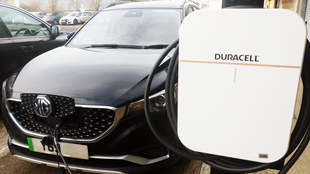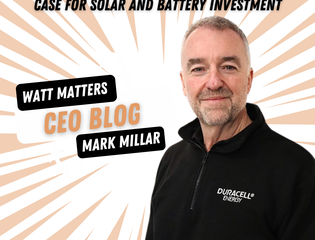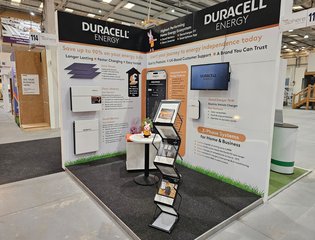Preparing For Your Home EV Charger Installation
20 January 2024

If you are looking to join the growing numbers of people moving to electric cars, installing a home EV charger is a sensible idea.
Having a home EV
While you can charge your electric vehicle using public charging stations, the simplest is to charge your car overnight. Installing a home EV charger means you can simply pull up and plug in, and by the morning, you will have one fully charged car ready for the day ahead. But, if you are considering installing an EV charger, ensure your home is EV-ready.
How Home EV Charging Works
While you can technically charge your car using a standard three-pin plug, it is not advised. A dedicated EV charging point is designed to use a 7kW charge, which can safely charge your electric car overnight. Some charging units, such as ours, can connect to your home energy storage system, allowing you to create a completely green and self-sufficient home.
With solar panels, an energy storage system, and an intelligent EV charging system, you could power your car using the oldest power source in the world—the sun. Not all EV charging systems are this intelligent, so if you are interested in this, even if not currently, it is worth considering when you are choosing your home EV system.
Assessing Your Electrical System
Charging your EV through your domestic electrical system does put an additional load through your home. Modern electrics should be sufficiently well-designed and installed to support an EV charger, but older electrics may need to be more robust. A professional should install your EV charger, as electrics can be dangerous. Always ensure that the person who fits your EV charger is a qualified and competent electrician who has passed the relevant qualifications. They should qualify for charge point installation (2921) and be registered with the Competent Person Scheme.
Choosing the Right Location
As ever, a good location is essential. You want to install an EV charger that is easy to use, safe and practical. Ideally, it needs to be near your electric board and where you park your car. Generally, people locate their EV chargers in the front of their house, making it very easy, when you drive up, to plug your car in simply. The easier it is to use, the better. Remember, if you only have street parking in front of your house, you cannot trail a cable across the pavement, as this causes a trip hazard for pedestrians, so domestic EV chargers can only be installed where there is parking space by a house.
Selecting the Right EV Charger
There are different types of chargers, and you may need clarification on which is best for your home use. The three main types are slow, fast and rapid. Rapid chargers are commonly found at motorway service stations and can charge an EV battery to around 80% in about 40 minutes. Fast chargers are found out and about, such as at retail parks and homes, as high-quality home chargers. They vary in power but generally fully recharge an EV battery within 6 to 8 hours. Slow chargers can take up to 12 hours to fully charge an EV battery, commonly found in lampposts for on-street charging. Our Duracell Energy DuraCharger is a fast charger fully compatible with different connectors.
Preparing Your Home for Installation
When you have decided to go electric, you need to get prepared. Make sure the installer’s work area is clean and tidy, with no hazards that they could trip over. Check that the wall area where you are planning for your EV charger is in good order and has no obstacles. Remember that your electrician will also need clear access to your electrical panel to wire in your new EV charger.
Hiring a Qualified Electrician
Electrics are dangerous and must only be altered by a qualified, professional electrician. You must ensure your electrician has the necessary training and certification to install EV chargers. They will need to be qualified for charge point installation (2921) and be registered with the Competent Person Scheme. Some electricians are registered with the OZEV scheme, which allows them to fit EV chargers under the grant scheme, but if you are self-funding your EV charger, you don’t need to choose an OZEV-registered electrician. However, this is a simple way to ensure they are fully qualified and competent.
Scheduling the Installation
Your EV charger installation should take around 2 hours. Obviously, this will vary depending upon the location of the EV charger the electric panel and the complexities that each job brings. Remember that your power will need to be turned off for some time. Consider this when scheduling your installation. Choose a time when you can manage without power or block off the time so that you know you won’t have power during this time. With more and more people working at home, it is important to factor this in.
Post-Installation Considerations
Your electrician should tidy up after themselves and leave you with your newly installed EV charger. So, charge away! Ideally, you will have installed your EV charger before receiving your electric car so that you are all ready, but you may have had the car beforehand. You will be delighted to plug your car in overnight without even driving around to find somewhere to charge it during the day.
Choose a Duracell Energy Duracharger for Premium Quality
You can create an entirely self-sufficient green home using the sun’s power, our premium energy storage system, and our Duracharger EV charging point. With our innovative app, you can choose the best charging mode for you, whether using your home-generated solar power or tapping into the grid at the best time of day; our app works for you.
Our EV chargers are designed and manufactured to the highest standards, giving you peace of mind for your charging needs. Take control of your world and go electric with a Duracell Energy Duracharger.


